
- •Лекция 1. Fundamental concepts of electromagnetics. Electrostatics. (Начало электростатики)
- •Vectors and scalar fields. (Векторные и скалярные поля)
- •Electrostatic field. (Электростатическое поле)
- •Coulomb’s Law. (Закон Кулона)
- •Electric Field Strength e and Displacement Field d. (Напряжённость и смещение электрического поля)
- •Gauss’ Law. (Закон Гаусса)
- •Electric Potential. (Электрический потенциал)
- •Work in the electric field. (Работа в электрическом поле)
- •Dielectric polarization. (Диэлектрическая поляризация)
- •Dielectric material characteristics. (Характеристики диэлектриков)
- •Properties of dielectric materials. (Свойства диэлектрических материалов)
- •Poisson’s and Laplace’ s equations. (Уравнения Пуассона и Лапласа)
- •Лекция 2. Boundary conditions for the Laplace or Poisson equations (Граничные уравнения для уравнений Лапласа и Пуассона)
- •Electrostatic Energy (Электростатическая энергия)
- •Virtual experiment. (Эксперимент по нахождению энергии системы)
- •Consequences (Следствия)
- •Continuity Equation (Уравнение непрерывности)
- •Лекция 3. Static magnetic field (Статическое магнитное поле)
- •Variables and units (Переменные и единицы измерения)
- •Main Relations (Основные соотношения)
- •Magnetic flux density (Индукция магнитного поля)
- •Biot-Savart’s law (Закон Био-Савара)
- •Ampere’s law (Закон полного тока)
- •Scalar magnetic potential (Скалярный магнитный потенциал)
- •The cut in the space (Разрез в пространстве)
- •Laplace equation for the scalar magnetic potential (Уравнение Лапласа для скалярного магнитного потенциала)
- •Vector magnetic potential (Векторный магнитный потенциал)
- •Magnetic flux (Магнитный поток)
- •Differential equation for the vector magnetic potential (Дифференциальное уравнение для векторного магнитного потенциала)
- •Gauging of the vector magnetic potential (Калибровка векторного магнитного потенциала)
- •Integral presentation of the vector magnetic potential (Интегральное представление векторного потенциала)
- •Inductance (Индуктивность)
- •Mutual inductance (Взаимная индуктивность)
- •Inductance of thin contours (Индуктивность тонких контуров)
- •Field intensity inside a cylindrical conductor (Напряжённость поля внутри цилиндрического проводника)
- •Лекция 4. Method of images (метод зеркальных изображений)
- •Equivalent charge density (эквивалентная плотность заряда)
- •Method of images for cylindrical boundaries between dielectrics (метод изображений цилиндрических границ между диэлектриками) Problem formulation (постановка задачи)
- •The inverse point (обратная точка)
- •Normal component of the field intensity (нормальная составляющая напряжённости поля)
- •Geometrical relations (геометрические соотношения)
- •Angles (углы)
- •Field induced by the line sources (поле, индуцированное линейными источниками)
- •The field sources for the external domain (источники полей для внешней области)
- •The field sources for the internal domain (источники полей для внутренней области)
- •Image method for the flat boundary between magnetic media (Метод изображений для плоской границы между магнитными носителями)
- •Equivalent magnetic charge density (Эквивалентная плотность магнитного заряда)
- •Dependence of the field intensity on the coordinate (Зависимость напряжённости поля от координаты)
- •Inductance of the two-wire transmission line per unit length (Индуктивность двухпроводной линии передачи на единицу длины)
- •Total inductance (Общая индуктивность)
- •Forces. The first line. (Силы. 1ая линия)
- •Forces. The second line. (Силы. 2ая линия)
- •Лекция 5. Solution of Laplace’s equation by separation of variables. (Решение уравнения Лапласа методом разделения переменных) Application of Laplace’s equation (Применение уравнения Лапласа).
- •Choice of a coordinate system (Выбор системы координат)
- •Variable separation in cylindrical coordinates (Разделение переменных в цилиндрических координатах)
- •Angular function (Угловая функция)
- •Radial function (Радиальная функция)
- •General solution of the Laplace’s equation in a cylindrical coordinate system (Общее решение уравнения Лапласа в цилиндрической системе координат)
- •Application of the variable separation method for the magnetic field modeling (Применение метода разделения переменных для моделирования магнитного поля)
- •Reduced scalar magnetic potential (Редуцированный скалярный магнитный потенциал)
- •Combination of scalar magnetic potential and reduced magnetic potential (Комбинация скалярного магнитного потенциала и редуцированного магнитного потенциала)
- •The scalar potential induced by the current line (Скалярный потенциал, индуцируемый линией тока)
- •The current potential in the cylindrical coordinate system (Потенциал от линии с током в цилиндрической системе координат)
- •The current potential in the complex plane (Потенциал от линии с током в комплексной плоскости)
- •Expansion of the current potential in the cylindrical coordinate system (Разложение потенциала от линии с током в цилиндрической системе координат)
- •Potentials in the problem domain (Потенциалы в проблемной области)
- •Inductance of the two-wire transmission line per unit length (Индуктивность двухпроводной линии передачи на единицу длины)
- •The flux induced by the magnetized cylinder (Поток, индуцируемый намагниченным цилиндром)
- •Лекция 6. Time dependent electromagnetic fields (Зависящие от времени электрические поля)
- •Faraday’s Law (Закон электромагнитной индукции)
- •Lenz’s Law (правило Ленца)
- •Induction by a temporal change of b (Индукция за счёт временного изменения b)
- •Induction through the motion of the conductor (Индукция за счёт движения проводника)
- •Induction by simultaneous temporal change of b and motion of the conductor (Индукция одновременным изменением во времени b и движением проводника)
- •Unipolar generator (Униполярный генератор)
- •Hering’s paradox (Парадокс Геринга)
- •Periodic electromagnetic field in the conductors. (Периодическое электромагнитное поле в проводниках)
- •Penetration of the electromagnetic field into a conductor. (Проникновение электромагнитного поля в проводник)
- •The skin effect. (Скин-эффект)
- •Poynting’s Theorem. (Теорема Пойнтинга) Electromagnetic Field Energy. (Энергия электромагнитного поля)
- •The rate of decrease of the electromagnetic field energy in a closed volume. (Скорость уменьшения энергии электромагнитного поля в замкнутом объёме)
- •Energy flows in the electromagnetic field (Поток энергии в электромагнитном поле)
- •Transmission of energy in a dc line (Передача энергии в линиях постоянного тока)
- •Transmission of energy in a dc line (Передача энергии в линиях постоянного тока)
- •The field picture near the wires with current (Картина поля вблизи провода с током)
- •Energy flows in static fields (Поток энергии в статических полях)
- •The momentum of the electromagnetic field (Момент электромагнитного поля)
- •The momentum of the electromagnetic field (Момент электромагнитного поля)
- •Лекция 8. Numerical Methods of the Electromagnetic Field Modeling. (Численные методы моделирования электромагнитного поля) Classification of the numerical methods (Классификация численных методов)
- •Classification of the problems (Классификация проблем)
- •Classification of the methods (Классификация методов)
- •Method of moments (Метод моментов)
- •Discretization of the problem domain (Дискретизация проблемной области)
- •Algebraic equation system (Алгебраическая система уравнений)
- •Finite element method (Метод конечных элементов)
- •Discretization (Дискретизация)
- •Finite functions (Ограниченная функция – отлична от нуля только в пределах треугольника)
- •Approximation of functions inside triangles (Аппроксимация функций внутри треугольника)
- •Approximation of the equation (Аппроксимация уравнения)
- •Weighted residual method (метод взвешенных невязок)
- •Galerkin method (метод Бубнова-Галеркина)
- •Weak formulation (ослабленная формулировка)
- •First type boundary conditions (Первый тип граничных условий)
- •The potential and field intensity (Потенциал и напряжённость поля)
Inductance of thin contours (Индуктивность тонких контуров)
We shall consider a round coil, consisting of one wire. The radius of the wire itself is much smaller than the radius of the contour.
In such case total magnetic field may be split in two parts. The first part – field which is circulate outside the wire (external magnetic field). And the part of the magnetic field which circulate inside wire.
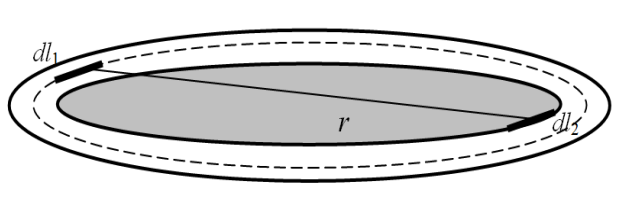
Grey surface crossed by the external flux.

Field intensity inside a cylindrical conductor (Напряжённость поля внутри цилиндрического проводника)
I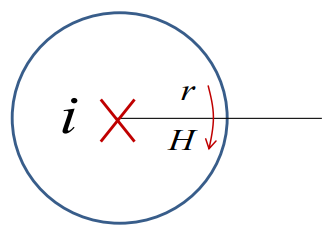 nfinitely
long cylindrical wire with the radius of R,
and the current of i.
nfinitely
long cylindrical wire with the radius of R,
and the current of i.
The field intensity inside the conductor at the point with the radius of r satisfies the Ampere Law.

 -
current which crosses chosen contour.
-
current which crosses chosen contour.
Directions
of the intensity vector and
 vector are the same.
vector are the same.
This integral may be replaced by:

Current density:

Field intensity:

Flux linkage of a thin current layer (Потокосцепление тонкого слоя с током)
Consider a thin cylinder with the radius of r and the thickness of dr
T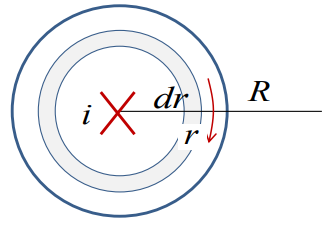 he
current inside this layer is:
he
current inside this layer is:

The flux per unit length:
In principle we assume that somewhere there should be wire with the opposite current.

After integration:

The flux linkage of a thin layer:
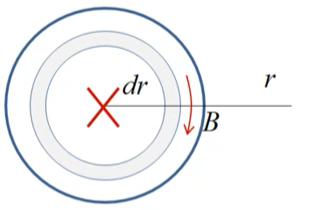

Total internal flux linkage:

or:

Internal inductance of a thin conductor (Внутренняя индуктивность тонкого проводника)
Transformation of the last integral:

Taking into account the limits:

Final expression:

Internal inductance:


External inductance of two-wire transmission line (Внешняя индуктивность двухпроводной линии)
F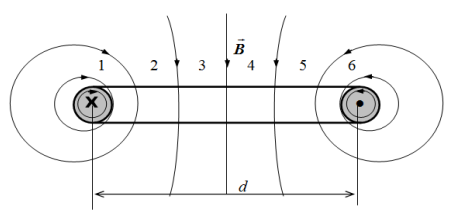 lux
density induced by a wire:
lux
density induced by a wire:

External flux:

R – radius of the wire; R<<d
Similar flux induced be the second wire.
The total external flux:

Flux linkage:

Inductance:

Internal inductance:

External inductance:

Лекция 4. Method of images (метод зеркальных изображений)
Image method for the flat boundary between dielectrics (метод изображения для плоской границы между диэлектриками)
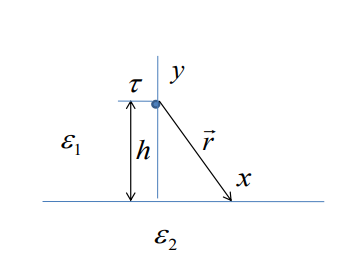
Application of the image method is not so evident. Look at this picture. Here the electric field exists in both half-spaces. Each half-space requires separate solution. We can notice this flat surface. It is this horizontal line. This dot corresponds to a charged line. Infinitely long charged line with the linear charge density τ. This charged line suspended above this surface at the high h. This surface is really an interface between two dielectrics with different properties. Above this surface the dielectric permittivity is equal to ε1 below the dielectric permittivity is equal to ε2. Find the field intensity distribution everywhere in the space in both sub-spaces (above the interface and below the interface (граница раздела)).
The electrostatic problem is described by the Poisson and Laplace equations. This equation has a unique solution in the case when we have defined proper boundary conditions. This may be definition of the potential at the border of the considered space; or normal derivative of the electric potential or intensity of the electric field because the normal derivative of the potential is really the normal component of the electric field intensity or if the medium has the constant dielectric permittivity, then it is identical to the case when we shall define a normal component of the field displacement.
 - field induced by charged line source. This
expression works only in the case when there are no surfaces. There
is only one space with one dielectric permittivity is everywhere the
same.
- field induced by charged line source. This
expression works only in the case when there are no surfaces. There
is only one space with one dielectric permittivity is everywhere the
same.
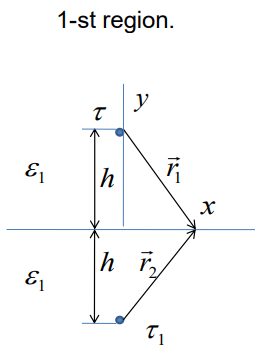
Let's suppose that the electric field in the upper
half-space above the interface may be calculated as the superposition
of two electric field. The first of them induced by initial wire
itself, by the primary source. However, there will be also a
component, which is induced by another wire. The wire, which is
placed under the surface and which has a charge density
 1.
1.
Dielectric constant is the same in both
half-spaces ε1.
Let us place the image into the point of
![]() .
Charge density of the image is
.
Charge density of the image is
![]() .
.
Field intensity in the boundaries:
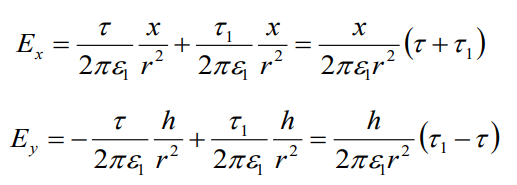
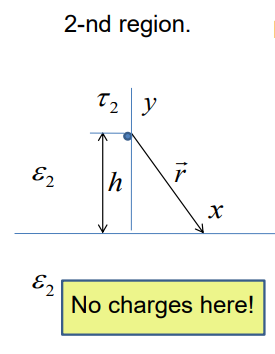
Let’s suppose that the dielectric permittivity
of the hole space is ε2.
Now there should not be any charge in the lower space. But above the
surface there will be a charge with unknown density![]() .
This charge, which is placed above the surface at the distance h.
.
This charge, which is placed above the surface at the distance h.
Field intensity at the boundaries:
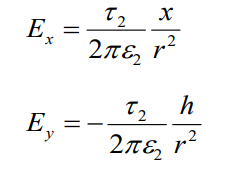
Boundary conditions are:

In the upper half-space

In the lower half-space

First relation
 or
or
![]()
Boundary conditions for vertical component of the
field intensity
![]()
In the upper half-space

In the lower half-space

Second relation:
![]()
Combining with the first relation:
![]() or
or

If the boundary conditions are satisfied then the solution is unique one. There are no other solutions. That is why such mirror reflection is the only one possible.
